Here are the best books and other things I read in 2012. More book reviews are available on my 2012 list page.
Books
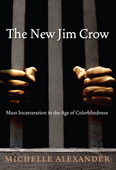 Michelle Alexander, The New Jim Crow: Mass Incarceration in the Age of Colorblindness
Michelle Alexander, The New Jim Crow: Mass Incarceration in the Age of Colorblindness
This is a really important book about how police departments, political institutions, and public apathy are conspiring to maintain an underclass of African-American “criminals” as a system of racial control. I am often skeptical of claims like this and I was almost completely convinced. This is an issue on which most well-intentioned people are wrong. I think sometimes Alexander’s rhetoric is more inflammatory than it needs to be (the evidence is enough to make her case) but it’s in the service of a good argument. The other flaw is one of omission: there’s very little discussion of the 20th century’s black radical political movements and efforts at prison reform.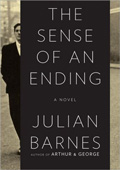 Julian Barnes, The Sense of an Ending
Julian Barnes, The Sense of an Ending
A beautiful, sad short novel about memory, love, shame, and getting older. I recommend you also read Colm Tóibín’s NYRB review of it.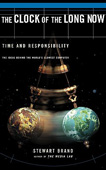 Stewart Brand, The Clock of the Long Now: Time and Responsibility – The Ideas Behind the World’s Slowest Computer
Stewart Brand, The Clock of the Long Now: Time and Responsibility – The Ideas Behind the World’s Slowest Computer
Wise essays about the concepts that led Brand and his collaborators to start the Long Now Foundation, which promotes slower thinking and cultural responsibility through strange projects like designing a huge clock that will last 10,000 years. Brand has a lot to say about the trajectory of technology and I think it’s valuable input, although I’m not going to start using 10,000-year notation (as in the year 02012).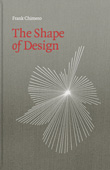 Frank Chimero, The Shape of Design
Frank Chimero, The Shape of Design
Provocative and inspiring questions about what designers do and why—the shape of design as in the outline, not the details, of the trade. Given the power to affect the experiences strangers have with objects, services, and places, what should designers do with that power? I liked this very much but found the writing kind of elliptical, often hinting at specific meanings rather than spelling them out with examples.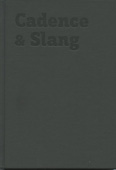 Nick Disabato, Cadence & Slang
Nick Disabato, Cadence & Slang
A short but comprehensive guide to interaction design principles and practices. It’s got everything from data visualization to copywriting to stakeholder interview techniques, and I agree with pretty much all of the explanations and advice. This is an introductory user experience class in 100 pages—a must-read for designers and people who work with them.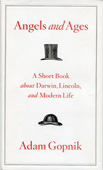 Adam Gopnik, Angels and Ages: Lincoln, Darwin, and the Birth of the Modern Age
Adam Gopnik, Angels and Ages: Lincoln, Darwin, and the Birth of the Modern Age
Abraham Lincoln and Charles Darwin were born on the same day in 1809, which serves as the excuse for this short comparative biography written 200 years later. Gopnik does an expert job at telling each man’s story in just enough detail to make a case that the two of them changed intellectual history (science and politics) in similar ways, through their parallel development of a new “liberal voice.” This is a great book on its own, but it also made me want to go and read more by both Lincoln and Darwin. You don’t have to agree with Gopnik that they were both engaged somehow in the same project to appreciate his thoughts on their work.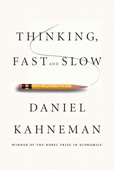 Daniel Kahneman, Thinking, Fast and Slow
Daniel Kahneman, Thinking, Fast and Slow
In this career retrospective, Daniel Kahneman reviews the last few decades’ progress in cognitive psychology, explaining what we know now about decision-making, biases, and errors of judgment. A very well written and insightful book with broad applicability to everyday life.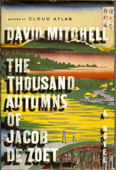 David Mitchell, The Thousand Autumns of Jacob de Zoet
David Mitchell, The Thousand Autumns of Jacob de Zoet
A perfect historical novel about a Dutch clerk in Japan in the early 19th century. It starts as a love story, then becomes a rescue adventure, and about halfway through I was unable to stop reading. Mitchell’s descriptive writing is as good as the story, which is to say, breathtaking.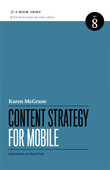 Karen McGrane, Content Strategy for Mobile
Karen McGrane, Content Strategy for Mobile
This isn’t about mobile phones any more. Karen McGrane has written a book about making your content work on every device with internet access—Create Once, Publish Everywhere, as NPR says. Content Strategy for Mobile describes a strategy for gradually abstracting content away from presentation (there’s a parallel here to the web standards movement of the 2000s and the separation of markup and style) and suggests that you start by making a business case for mobile content. Anyone in charge of a content-based website should read this.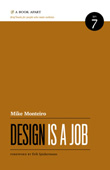 Mike Monteiro, Design is a Job
Mike Monteiro, Design is a Job
A very helpful short book about standing up for yourself, saying “Fuck you, pay me” when it needs to be said, and protecting your design practice with a solid business framework: contracts, change orders, payment schedules, and so on. This is some of the best advice I’ve read recently. Wish it was longer.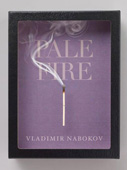 Vladimir Nabokov, Pale Fire
Vladimir Nabokov, Pale Fire
Pale Fire is a novel formatted as a long annotated poem, with most of the action taking place inside a commentary to the poem. The late poet John Shade’s friend and editor, Charles Kinbote, may be an escaped king or an insane professor. If that sounds complicated and obscure, that’s because it is. But the book is a treat—even Shade’s poem without Kinbote’s commentary is well worth reading.
One quibble: Nabokov seems to have stolen Kinbote’s unusual origin story from a turn-of-the century adventure novel, Anthony Hope’s The Prisoner of Zenda, down to the royal lookalikes and the imaginary country starting with a Z. Zembla is pretty clearly Zenda. But that’s part of the book’s game, like mentioning “lolita” and professor Pnin.
Essays and Articles
I’ve also compiled these into a Readlist that you can send to your Kindle, iOS device, or other e-reader as one long document.
- Craig Mod, “The Digital-Physical: On building Flipboard for iPhone and Finding Edges for Our Digital Narratives”
Craig worked hard on the Flipboard app for iPhone and didn’t want the team’s ephemeral, digital work to disappear. So he did something crazy: he made the design and development process into a book. I want a copy of it, but I’ll settle for this article. - Craig Mod, “A Pointable We (2/3)”
Another essay by Craig Mod explaining what’s so interesting about Findings, Readmill, et al.: they let us point into texts instead of just to them. - Dan Hill, “In Praise of Lost Time”
A wonderfully detailed review of the Facebook “timeline” redesign, bringing in Edward Tufte, Joan Didion, the Dunbar number, and lead designer Nicholas Felton. Thought-provoking and inspirational, even if you hate Facebook. - Charlie Loyd, “Think about Facebook: An angry reverie on software”
Speaking of hating Facebook. Here’s a wonderful, sprawling rant demanding rigor, context, and detail in the way we think about the philosophy of software. It’s deliberately unstructured but it works so, so well. - Jason Fried, “Give it Five Minutes”
This has been really valuable advice: before you argue against or reject an idea, take five minutes to let it sink in. I’ve tried to do this more in the last year. - Peter Wood, “How to Ask a Question”
Here’s similarly helpful advice from someone fed up with the quality of Q&A sessions. This is from an academic context but applies to any kind of speaker-audience situation. - Pablo S. Torre, “Larger Than Real Life”
A very interesting look at the lives of America’s seven-foot-tall people that makes me glad I stopped growing when I did. - Aaron Bady, “‘The Grass is Closed’: What I Have Learned About Power from the Police, Chancellor Birgeneau, and Occupy Cal”
Aaron Bady has been writing great stuff about Occupy Oakland, the UC tuition protests, and all kinds of other subjects for the last few years. This account of something that happened to him on campus last year is chilling and familiar from my own experiences in the protests of 2009. He uses it to explain exactly what’s wrong with how the administration handled student demonstrations. - Eric Rauchway, “Some notes on comparing Lincoln and FDR.”
I am not so interested in comparing presidents, but this is one of my favorite short descriptions of Lincoln. A debatable but good summary of his character and legacy. “He had a sense of humor he liked to inflict on others; his backwoods jokes did not always go over well but as President he did not have to care.” - Paul Ford, “10 Timeframes”
A lovely commencement speech to a graduating class of designers. Our time is not just our own anymore. - Angela Colter, “The Audience You Didn’t Know You Had”
A well written and important reminder that most web sites make bad assumptions about how much people are willing and able to read. On top of what highly educated people are willing to spend their time on, we have to consider users with low literacy skills—there are a lot of them. I’m certainly guilty of putting out way too much text for most people (for example, this post). - Tyler Cowen’s TEDxMidAtlantic talk about stories
A TED talk about why TED talks are dangerous, more or less. Very clever and entertaining. I recommend the video but the transcript stands on its own. - Alex Tabarrok, “Why 8 1/2 x 11?”
Some thoughts on why we’ve ended up writing and printing on paper that’s pretty much objectively the wrong size. How strange our path dependencies make us, and how natural they feel before we ask why. Ends with the best Marginal Revolution punchline of the year, which is why I link to this summary instead of the article it quotes. - Ian Storm Taylor, “Design Tip: Never Use Black”
Here’s a great tip that helps designs look and feel “right.” Once you know about this, you’ll see it everywhere. - Tamar Lewin, NYT, “Taking More Seats on Campus, Foreigners Also Pay the Freight”
A very interesting look at how and why more Chinese students are attending U.S. colleges like the University of Washington. Here’s UW president Michael Young: “Is there any advantage to our taking a kid from California versus a kid from China?… You’d have to convince me, because the world isn’t divided the way it used to be.” I’d love to hear more on this topic from decision-makers.